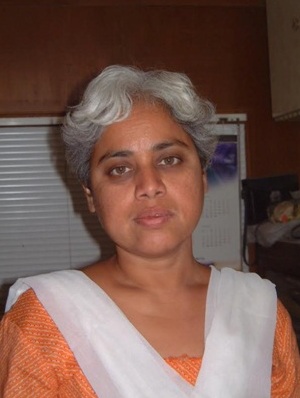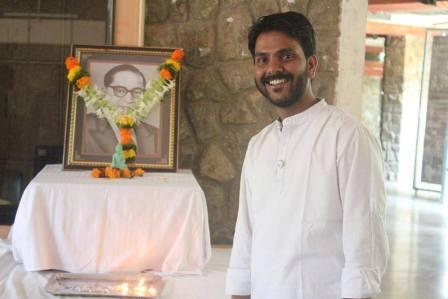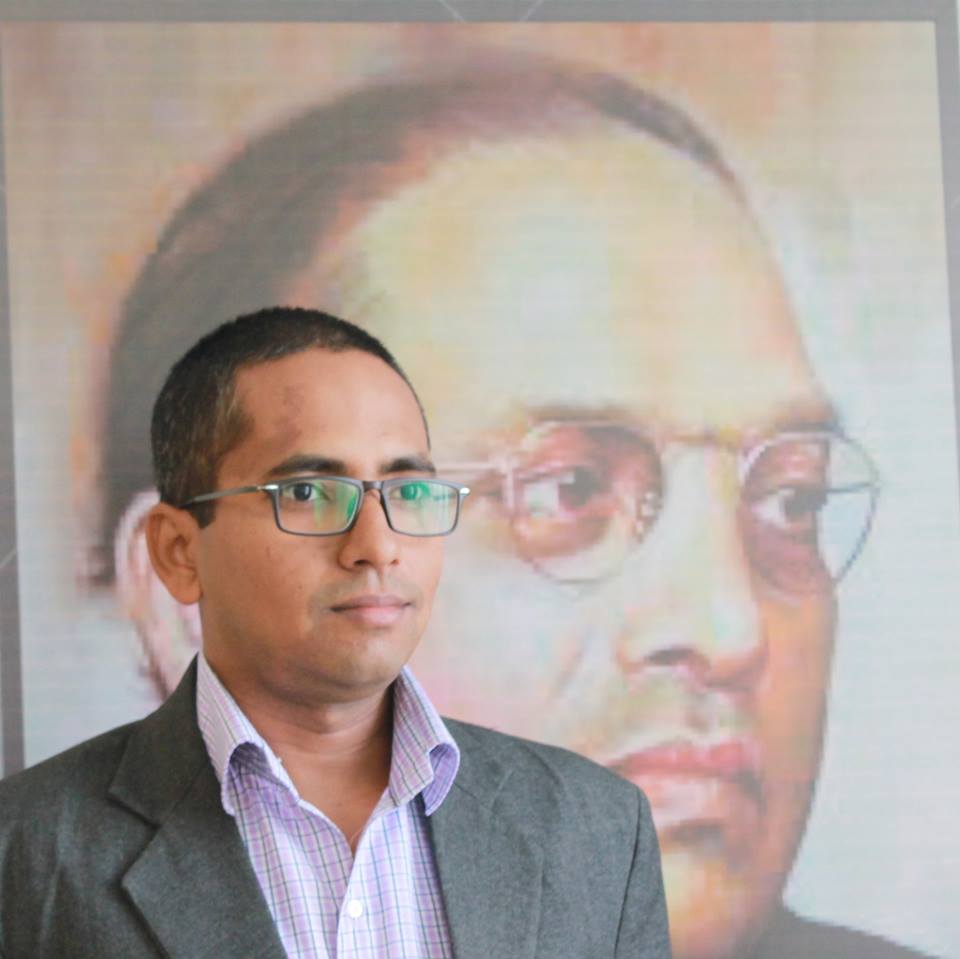Essay 5. ‘What Babasaheb Ambedkar Means to Me’
Gouri Patwardhan
 My first encounter with Dr. Babasaheb Ambedkar outside the school textbook was at the age of 31. I was working as an interpreter cum research assistant with a German documentary filmmaker on a film on Dr. Babasaheb Ambedkar in 1997.
My first encounter with Dr. Babasaheb Ambedkar outside the school textbook was at the age of 31. I was working as an interpreter cum research assistant with a German documentary filmmaker on a film on Dr. Babasaheb Ambedkar in 1997.
That was the first time I went to New Modikhana; a predominantly Dalit neighborhood and the center of Ambedkarite movement, in the eastern part of Pune to meet the family of Waghmares. Most researchers, academics working on Maharashtra and Dalits went to meet the Waghmares through an introduction from Dr. Eleanor Zelliot and that’s how I too had reached there; through the good office of the western scholar.
Until that day I believed I had no caste and I belonged in a casteless world. Then I became painfully aware that it wasn’t just the world of my extended family that had caste but my own world outside the family- of artists, filmmakers and intellectuals also had caste and it was neatly uniform; it was upper caste. It was mostly Brahmin. It was also homogeneous geographically without seeming so. It was a dream world, smug and arrogant. The idea of individuality on which my identity was based was cracked.
But it took a decade and the two films that I made with Sudhir and Pushpa Waghmare to begin seeing the intricate relationships between Dr. Ambedkar and his people and the anti-caste struggle. And more importantly, to realize that the modernity of my world; between the art college and the film school was quite hollow and superficial.
Pushpa Waghmare was a primary school teacher in schools run by the Pune Municipal Corporation. In that shocked state of mind, of becoming aware of my caste location, the only thing I registered through conversations with her was that a Dalit teacher can make a real difference to Dalit-Bahujan students. She took me around to the areas of Kasewadi, Bhavani Peth, Nanapeth and Modikhana to her students’ home. I hadn’t met teachers who knew their students families so well before; I hadn’t met a teacher with this kind of empathy and understanding before. She constantly emphasized how Dr. Ambedkar’s teachings made this possible. I made a short documentary on her work in 1999.
It was only 9 years later when I began working on Modikhanyachya Don Goshti (Two tales of Modikhana ) that I really began to grasp Dr. Ambedkar’s political ideology and its truly revolutionary dimensions.
Through daily visits to Modikhana and conversations with Sudhir Waghmare and his family over a period of a year and through reading of Dalit autobiographies and works on and by Dr. Ambedkar, I was able to see, slowly, how the great leader had shaken and motivated his people into challenging the caste system and brought about a revolution.

The Ambedkarite community in the cyberspace, mainly the Insight blog and later Round Table India contributed greatly in shaping my understanding.
But I believe that it was only through those daily interactions with the Waghmares and the neighborhood that I learned the greatness of Dr. Ambedkar.
Every day as I travelled from the western part to the eastern part of the city- crossing Bajirao Road (one of the dividing caste lines between Savarna and Bahujan Pune); the distance seemed to increase in sharpness with time as I became more and more aware of the gap between the two worlds.
It was a huge education to see how a whole community rejected the exploitative Hindu religion bravely and completely through the recollections of Sudhir Waghmare about the conversion to Buddhism after 1956 and through what I saw families practice around me in Modikhana.
By this single act the Mahar community was transformed beyond words. In Waghmare’s words, ‘Ugly practices like Devdasis and animal sacrifice and getting possessed by gods stopped immediately (after the conversion). People threw the idols in their houses into the canal. People realized that they were following these rituals because of their ignorance. They gave up eating dead meat and refused to perform their traditional duties in the village economy.’

This very conscious creation of a new identity rooted in an ideology that opposed the unjust Brahminical religion- the courage needed for it was very visible through Waghmare’s words.
‘…It was a test of our belief, as the Savarna samaj reacted violently to the conversion, particularly in rural areas. Our people were denied food and water, their livelihood was taken away, in some places women were paraded naked.’
‘…As they declared ‘Bahiskar’ (boycott) on us we too declared bahiskar on their gods’
‘… All the temples that belonged to the Mahar community were converted into Buddha Viharas.’
Balanna Nimal
Sudhir Waghmare’s teacher who introduced him to Dr. Ambedkar was Balanna Nimal, a dedicated follower of Dr. Ambedkar. It was impossible for Waghmare Saheb to speak about Dr. Ambedkar without speaking about Balanna.

Balanna was a Telugu ‘chamaar’ (probably Madiga) by caste and worked in a small shoe shop on Main Street in Pune. Nothing else mattered to him than spreading Babasaheb’s thoughts. He was a true soldier of Dr. Ambedkar who followed Babasaheb’s path with determination.
Balanna inspired the youth in Modikhana and adjoining areas of Bheempura, Phadai by reading out from Periyar and Ambedkar. Every afternoon when his shop shut for a few hours he would sit outside his house at a corner square in Modikhana surrounded by youngsters. He organized games and skits and drama competitions and tried to bring his Chamar community into the anti-caste movement led by Babasaheb. ‘Only Balanna had the skill to bring people together’ says Waghmare.
Balanna, though facing hardships, tried to provide a safe and protected life for his partner, a Devdasi. This invited wrath from his community.
He went to participate in the Mahad satyagraha on bicycle from Pune along with his friends. His recounting of these events was itself very inspiring for the youth in Modikhana. A natural singer and performer he used to perform Lalits, a traditional folk form and Keertans to create awareness about social injustice. He then started composing Bheem geets and singing them with his Gayan Party.
He was at the forefront of the movement of conversion to Buddhism. He established Bheem Seva Samaj in the late 1940’s and started educating people about Buddhism and the reasons to adopt it. After the Mahar community in Pune converted to Buddhism in 1957 he tried to, through Bheem Seva samaj establish Buddhist ritual practices in the community.

Waghmare Saheb regrets that the notebooks containing Balanna’s poetry are lost. He only remembers a few lines from some of them and there are a few photographs of his Gayan Party taken by Dr. Zelliot sometime in 1960’s. But the power of that poetry is evident in his eyes.
‘Gorya Saheban raj dila ra beta nakali
swarthi kombdi dalgyat kokli’
(The Gora Sahib gave a false raj (to India)
and a selfish hen crowed from the chicken basket)
He recites two lines from one of Balanna’s sarcastic poem, full of irony, written on the eve of Independence of India that pokes fun at the selfish brahminical/upper caste congress leadership.

He feels very sad that such a great leader who gave his life to Dr. Ambedkar had to die in poverty and negligence because he was a Chamar. That he couldn’t win the only local body election he contested. That his family suffered after his death. But he feels grateful that his community respected his wishes about his last rites; he was cremated according to Buddhist rites.
For Sudhir Waghmare, Babasaheb, his teachings and Balanna are inseparable.
Born in 1937 Sudhir Waghmare grew up listening to Kabir bhajans and traveling to Pandharpur as a Varkari. He saw untouchability being practiced in Pandharpur though the Bhakti cult claimed to rebel against the Brahminical hold on religion.

The time of his teenage and youth, from around 1950 into 1960’s -his community was going through the turmoil of a revolution; shedding its emotional and spiritual links with the old Bhakti religion. This period was marked by heightened political activity of Dr. Ambedkar’s meetings, Satyagrahas for the landless in 1946, debates about Buddhism and political rights of Dalits… the scheduled caste federation and elections. It was Balanna through whom he and many young people like him absorbed it all. They urged their hesitating mothers and elders to be bold and follow Dr. Ambedkar.
I have listened to numerous stories of Balanna while walking the lanes of Modikhana and Bhimpura with Waghmare Saheb and sitting in his small studio home under the shadow of portraits of Balanna and Babasaheb and Shivram Janba Kamble that he has painted. It’s as if his presence is felt through the atmosphere in this district in Pune silently through the Viharas, through images of Babasaheb and the Buddha that dot the area.
It is not possible for me to capture in words the depth of Sudhir Waghmare’s rendering of Balanna and through him of Dr. Ambedkar. What I have managed to capture on video is just a fragment of what he has spoken otherwise.
I can only imagine what a powerful and great teacher Balanna must have been as I learnt from Sudhir Waghmare about Dr. Ambedkar’s teachings.

In a way, for me Dr. Ambedkar and his teachings can’t be separated from his people. It is a lived ideology for which they have given their blood.
I was fortunate to have met the Waghmare family via Dr. Eleanor Zelliot and spend time at their home. Through them I saw the community as people who lived the ideology of their leader and preserved it through individual and collective efforts. Through the imagery of him they created in poetry, songs, performance and literature and the practice of Dhamma. Through many scholarly works they published on him and by him.
The enduring image is of young and old people lost in thought as they go through books at bookstalls at any Ambedkarite event or celebration that take place round the year.
So it seems logical that this should escape my upper caste world and community of elite intellectuals, artists, writers, journalists, poets and filmmakers living as we do in a segregated world.

It is as if we are all sitting in ‘Camera Obscura’, that dark room in which the world is projected upside down through a hole. It is through here that we would like to control the world outside, weave our narratives of justice and equality that hide our privileges and yet be its protagonist to perpetuate the Brahminical power, while claiming the opposite. Reading Ambedkar from here can only amount to appropriating him or other Dalit icons. That’s why we don’t understand that Ambedkar can’t be read without his people.
~~~
Gouri Patwardhan is an Artist and Filmmaker currently based in Bangalore. Gouri’s experience as a film maker and editor began with making educational films for children and young adults for NCERT and UGC on themes of art, environment and inventive pedagogical practices, after graduating from Goa College of Art and a post graduate diploma from Film and Television Institute of India,Pune.
Her recent independently produced documentary, Modikhanyachya Don Goshti (Two Tales of Modikhana) 2011,explores an urban Dalit Bahujan neighborhood through the artistic lens of two Dalit artists. Gouri is currently working on a documentary, looking at how culture and heritage is constructed in the urban context of Pune.










